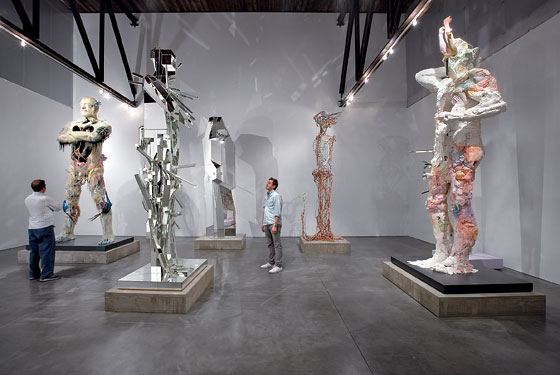
Standing in David Altmejd’s gothic-surreal show is like being in a forest of freakish giants from the dawn of time. Nine twelve-foot-tall colossi tower above you like oversize werewolves, rotting Wookiees, or sculptures of pharaohs from some sci-fi porn planet. It’s an Oedipal grove of powerful deteriorating fathers and beautiful but monstrous sons. These creatures have mirrored derrières, plump penises decorated as if by a jeweler, gashes in colorful torsos, dozens of hands holding giant testicles or crystalline daggers. One figure has a peacock encircling each thigh; two have twisting energy fields or stigmata sprouting from hands and heads.
Altmejd’s exhibition is a combination sideshow, intergalactic cyborg showroom, and kitsch emporium. It’s simultaneously hideous and beautiful—and transitional. He’s gone from integrating hairy decapitated wolfmanish figures into room-filling architectural-sculptural installations, complete with sprawling bases that were themselves surreal landscapes, to the figures alone.
The good part of this transition is that Altmejd is letting fly his ideas about growth, decay, polymorphous sexuality, handmade sculpture, autobiography, and scale. His use of craft, abstraction, and strange archaic materials like horsehair and mirrors connects him to excellent emerging artists like Sterling Ruby, Huma Bhabha, and Jessica Jackson Hutchins (who has a knockout exhibition at Derek Eller Gallery), as well as to the scratchy figures of Kiki Smith and Louise Bourgeois. None of these artists, including Altmejd, has a signature style; all are intentionally all over the place; when they fail they fail in garish ways.
Some of Altmejd’s sculptures look like cheesy displays from Planet Hollywood. Yet his work is so scrupulously handmade that you sense him discovering it as he goes along. Materials and processes seem to assert themselves. He’s the opposite of Takashi Murakami and Damien Hirst, artists who also create oversize figurative sculpture but who draw plans up, then job them out.
The bad news about Altmejd’s transition is that removing the figures from their fragmented environments, which overwhelmed the eye and seduced the mind, limits them. On their own now, they appear somewhat forlorn. That’s a significant problem, but it doesn’t mean there’s not a lot going on here. Altmejd, 33, who lives in New York and who represented his native Canada at the 2007 Venice Biennale, has said that he thinks of the body as “a little world” or “a total universe,” and that he wants his sculptures to strike one as “being alive and being able to develop … intelligence and generate meaning.” This echoes Walt Whitman’s “I contain multitudes” mania about the body and self. Altmejd is like some Dr. Frankenstein (whom he has called “the ultimate sculptor”) making beautiful monstrosities come to strange life. He claims “things look more alive when they’re growing on top of what’s dead.” As Hannah Arendt put it, “the process of decay is at the same time a process of crystallization.”
Here, decay turns into form that decays again. It’s possible to read the exhibition as a kind of Genesis narrative, going from pure energy to prehuman form to post-human being. The story begins with The Cave, a tall mirrored spike that looks like a bolt of energy from heaven, and progresses through figures that variously evoke Michelangelo’s Slaves, golem-shaped lymphatic systems or skeletons, and a blond creature in a state of dreaming or becoming. That last one turns into The Spiderman, the most typically human piece here—except that things shoot out of his forehead and chest. The Shepherd is overgrown with hair and holds his arm over his face; crystals grow from his feet and chest; a fantastic mirrored stairway coils around his body. This piece suggests that the best way through this transition is for Altmejd to merge the architectural and the figurative. Finally, in The Guide, the figure is all mirrored again, as if it were returning to the cosmos from which the original bolt came.
There’s another narrative going on in that progression as well. Altmejd has recapitulated the history of freestanding figurative sculpture, going from Neolithic monolith to standing Egyptian gods to archaic Greek sculptures to Michelangelo’s David to fragmented modernism. At a time when many artists are simply recombining Warhol and looking for clever ways to make cool art about commodification, it’s enriching to see Altmejd make art not just out of the art world but out of himself.
David Altmejd
Andrea Rosen Gallery.
Through June 14.
E-mail: jerry_saltz@newyorkmag.com.